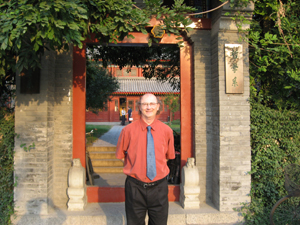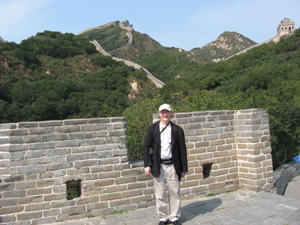Search for:
GENERAL
HISTORY
>
Jay Goulding presented the
Bata Shoe Museum Asian Heritage Month Lecture
in May 2007.
JAY GOULDING | He is Professor at Atkinson School
of Social Sciences, York University. His expertise is in classical
and contemporary Chinese philosophy as well as hermeneutics and
phenomenology. He is appointed to the Graduate Programmes in
Social and Political Thought, Communication and Culture, Education,
and Sociology.
He has published widely in
various scholarly journals including Journal for the Scientific
Study of Religion, Sociological Analysis: A Journal of Comparative
Religion, Political Theory, Catalyst, Anhui Normal University
Journal of Social Sciences and Humanities, Dao: A Journal of
Comparative Philosophy, Journal of Chinese Philosophy, International
Journal for Field-Being, Asian Cinema, and China Review International.
He has written for the six-volume Scribner's New Dictionary of
the History of Ideas encyclopedia with entries on Chinese and
East Asian philosophy, culture, language, history, politics and
society in both ancient and modern perspectives. In 2001, he
participated in the official return of philosophy to China with
the International Society for Chinese Philosophy, and the Chinese
Academy of Social Sciences. As well, he contributed an essay
to Beijing's University's journal, Gate of Philosophy, celebrating
the one hundredth anniversary of the university and the first
English language edition of a premier journal of Chinese philosophy.
In the summer of 2005, he co-chaired
the "Ontology and Hermeneutics" conference in Shanghai
that celebrated the seventieth birthday of the prominent Chinese
philosopher Cheng Chung-ying, founder of the International Society
for Chinese Philosophy, whose work is instrumental in the rebirth
of comparative philosophy between China and the West. In the
fall of 2006, Goulding delivered guest lectures at Beijing Foreign
Studies University's Foreign Literature Institute, and at Beijing
University's Institute of Foreign Philosophy where he explained
the relationships between Daoism and phenomenology, especially
the Chinese classical Daoist philosophers Laozi and Zhuangzi
as compared with the seminal European thinkers Martin Heidegger
and Maurice Merleau-Ponty. In 2008, he finished editing a book,
China-West Interculture: Toward the Philosophy of World Integration,
Essays on Wu Kuang-ming's Thinking for The Association of Chinese
Philosophers in America series with Global Scholarly Publications
in New York.
 Since York
University offers a diverse venue for teaching non-traditional
topics to non-traditional students, Goulding develops non-traditional
ways of disseminating knowledge regarding emerging areas of scholarship,
namely a comparison of Eastern and Western societies. His theoretical
and methodological bases of research and teaching are reciproc-al.
They revolve around an approach whereby Eastern and Western civilizations
can be compared in terms of philosophy, religion, culture and
society. Research is as crucial for teaching as teaching is for
research. Hence, he calls his collective scholarly project "Global
Comparative Thought."
Since York
University offers a diverse venue for teaching non-traditional
topics to non-traditional students, Goulding develops non-traditional
ways of disseminating knowledge regarding emerging areas of scholarship,
namely a comparison of Eastern and Western societies. His theoretical
and methodological bases of research and teaching are reciproc-al.
They revolve around an approach whereby Eastern and Western civilizations
can be compared in terms of philosophy, religion, culture and
society. Research is as crucial for teaching as teaching is for
research. Hence, he calls his collective scholarly project "Global
Comparative Thought."
As Goulding suggests, China
today is in-between the old and the new, and in-between Eastern
and Western traditions. In recent years, many Daoist temples
have re-awakened in China, and many aspects of Confucian philosophy
have re-emerged. The prominent works of the Chinese neo-Confucian
philosopher Cheng Chung-ying and the Chinese Daoist philosopher
Wu Kuang-ming are most useful for addressing these transformations
as their writings are rich in cross-cultural comparisons. Their
intriguing blending of her-meneutic phenomenology, and Chinese
philosophy acts as a guide to addressing the vari-ous rifts within
and between these categories. In the last twenty years, Goulding's
re-search has been inspired by both Cheng's idea of 'onto-cosmology'
and Wu's idea of 'body thinking.' Both scholars examine the polar
rotations of Chinese thought as it un-folds through hermeneutic
(interpretive) analysis and phenomenology (changes in every-day
life). Confucianism and Daoism take turns at prominent roles
in Chinese history. Phenomenology reveals the intricate layerings
of these philosophical crossings by aware-ness of societal contexts.
Cheng's work on both neo-Confucian thinkers (Zhu Xi, Wang Yangming),
and on Heidegger is inspiring. It helps open up new horizons
for Chinese un-derstandings of hermeneutics as a search for the
truth, and is crucial for responding to the American tendency
to pragmatic reductions. A close study of Cheng's work allows
Goulding to re-read Heidegger's famous Chinese students (Xiong
Wei, Hsiao Shiyi, and Chang Chungyuan) in a new fashion that
introduces onto-ethics into an otherwise incom-plete ontology.
Cheng's philosophy is a path breaking guide for exploring the
in-between of East and West on philosophical, cultural, religious
and cosmological levels.
Likewise, Goulding's close
study of Wu's work activates both Eastern and Western me-taphoric
thinking as a two-way osmotic membrane. This meta-metaphor negates
itself while re-inventing new vistas and new horizons. The words
of the West and the expe-rience of the East interpenetrate each
other: the outside West in signs, the inside East in stories.
The West navigates from inside to outside, from psychic states
to daily expres-sions. The East navigates from outside to inside,
from mundane familiarity to the three teachings. In this sense,
both East and West are co-constitutive and mutually correcting.
Drawing strength from Zhuangzi's 'hollow,' and Heidegger's 'clearing,'
Wu argues that the West thinks too much with the mind while allowing
the body to disappear. The East lets the body do the thinking
while the mind descends down (trans-descends) into it. As Wu
insists, Chinese body thinking relies on the heart/mind (xin).
Eastern body thinking is 'concrete'; Western rationalist thought
is abstract.
Goulding maintains that although
Laozi takes us immediately to the centre of stillness, Zhuangzi's
parables are the key entrances back into an understanding of
the world of the everyday. In response to the rationality of
the Greek world, Heidegger lives on the boun-dary slash between
Being and Nothingness. Eastern philosophy helped him feel his
way (through poetry) into a fulfilled nothingness of 'the clearing,'
an opening that is free for brightness and darkness, and for
resonance and echo.
There are many challenges with
researching and teaching East Asian thought. Concepts of 'time,'
the 'person' and the 'self' are ingrained and imbedded into Western
modes of thought. In the West, 'time' is often seen as linear
or related directly to the clock; the 'person' is the fulcrum
for rights, values and property acquisition; 'self' is firmly
tied to the idea of the individual. In the East, 'time' is often
cyclic or eternal; 'self' (if existing at all) is firmly tied
to family and groups; the 'person' is often in-between and responsive
to combinations of Confucian virtues and Daoist cosmologies.
 Historically, China
has not shared many of the West's assumptions. Eastern civilizations
are built and sustained on different notions of all of the above.
However, this does not preclude some overlaps or forms of reconciliation,
especially if we are sensitive to the ancient past. For Goulding,
the hermeneutic task is to understand what these assumptions
are about, where they come from, and how do we get to them. This
involves a phenome-nological bracketing or suspending (even momentarily)
of the preconceived notions that we share in the West. The life-world
can be seen in terms of a series of concentric rings of perception:
social, philosophical, economic, political, psychological, cultural,
and cosmological. We can strip back each of these layers of perception
and investigate them as to composition and texture. Altogether,
they constitute a horizon. These rings generate a thick haze
around us that inscribes and defines our sense of being, time,
consciousness and morality. What a teacher wants to do is increase
vision outside this thick haze of per-sonal perception. In order
to understand these new horizons, we might have to put our own
out of action for a while. This does not mean giving up Western
(or Eastern) values or assumptions. It only means placing them
on the backburner for a while. This idea of 'withholding' or
'suspension' or 'bracketing' is not new. Rather, it is a generalized
activi-ty, more global in perspective than Cartesian radical
doubt. Minimally, it helps the teacher of East Asian and comparative
thought be more open to possibilities, and maximally, allows
the embrace of a new way of thinking. This method of interpretive
suspension that defines hermeneutic phenomenology can be attuned
to the present and to the daily events at hand.
Historically, China
has not shared many of the West's assumptions. Eastern civilizations
are built and sustained on different notions of all of the above.
However, this does not preclude some overlaps or forms of reconciliation,
especially if we are sensitive to the ancient past. For Goulding,
the hermeneutic task is to understand what these assumptions
are about, where they come from, and how do we get to them. This
involves a phenome-nological bracketing or suspending (even momentarily)
of the preconceived notions that we share in the West. The life-world
can be seen in terms of a series of concentric rings of perception:
social, philosophical, economic, political, psychological, cultural,
and cosmological. We can strip back each of these layers of perception
and investigate them as to composition and texture. Altogether,
they constitute a horizon. These rings generate a thick haze
around us that inscribes and defines our sense of being, time,
consciousness and morality. What a teacher wants to do is increase
vision outside this thick haze of per-sonal perception. In order
to understand these new horizons, we might have to put our own
out of action for a while. This does not mean giving up Western
(or Eastern) values or assumptions. It only means placing them
on the backburner for a while. This idea of 'withholding' or
'suspension' or 'bracketing' is not new. Rather, it is a generalized
activi-ty, more global in perspective than Cartesian radical
doubt. Minimally, it helps the teacher of East Asian and comparative
thought be more open to possibilities, and maximally, allows
the embrace of a new way of thinking. This method of interpretive
suspension that defines hermeneutic phenomenology can be attuned
to the present and to the daily events at hand.
Making sense of the whirlwind
of complex philosophical ideas from both Western and Eastern
traditions, Goulding finds popular culture to be a simple venue
to understanding everyday experiences. The process of searching
for or unveiling or revealing is a herme-neutic task. Thus, we
have the phenomenological method mapped into the hermeneutic
search for truth. In a very basic way, Goulding utilizes these
intricate ideas to unhinge assumptions and pre-judgments on both
sides of the fence: your own world and the world that you are
investigating. By engaging with the everyday, you are entering
the philosophy of the in-between. You are neither East nor West,
neither China nor Canada but somewhere in the middle. Goulding's
research, writings, and teachings try to gently navigate students
into the middle where they can help themselves better understand
Can-ada and the Middle Kingdom of China.
<<
top
 The project was made
possible with the support of the
The project was made
possible with the support of the
Department
of Canadian Heritage through the Canadian Culture Online Strategy
The Acrobat Reader
is available free from 